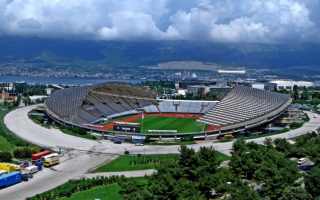Stadion Gradski u Poljudu (Poljudska Ljepotica)
| Capacity | 34 448 |
|---|---|
| 114 (VIP seats) | |
| 81 (Press seats) | |
| Country | Croatia |
| City | Split |
| Clubs | HNK Hajduk Split |
| Floodlights | 1800 lux |
| Inauguration | 1979 |
| Renovations | 2003 |
| Record attendance | 65,000 (Hajduk Split - Dinamo Zagreb, 1982) |
| Design | Boris Magaš |
| Address | 8 Mediteranskih Igara 2, 21000, Split, Hrvatska |
Advertisement
Stadion Poljud – stadium description
Construction of the Poljud district stadium was ready in 1979, when Split was hosting the Mediterranean Games. With this in mind the stadium referred to as 'Poljudska ljepotica' (The Beauty of Poljud) received extensive infrastructure for football, athletics and other disciplines. It was opened by Josep Broz Tito himself.
The design was unique and became inspiration for many others. Created by local architect Boris Magaš it has a concrete bowl of single-tiered stands varying in height – 54 rows along the pitch and 27 behind goals. Only the west and east sides are covered with light arches, both spanning over 215 meters. Despite being at the time of creation the world's largest roof of its kind, the structure is very light, weighing only 680 tons.
Initial capacity stood at 50,000 with end zones being terraces. Record crowd for the famous 'Croatian derby' exceeded capacity with about 65,000 people inside. Current size is a lot smaller due to all-seater regulations, up to 35,000 people may get inside.
Apart from Hajduk holding their games here, the stadium also saw several matches of the national team. Most of them were friendlies, though, and only the games from 1995 (vs. Italy) and 1997 (vs. Denmark) enjoyed capacity crowds.
Poljud was part of Croatia's joint bid with Hungary to host Euro 2012. The stadium was to have its roof extended to all stands and part of the pitch. The event was eventually granted to Poland and Ukraine.
In 2015 the building was listed as part of Croatia's protected cultural heritage.
Advertisement
Pictures
-

© Hajduk.hr 
02.01.2015 © Nathan Mizrachi 
2010 © Ballota (cc: by) 
2010 © Ballota (cc: by) 
09.09.2015 © BeskidzkaPilka.pl 
25.07.2012 © Roy Terstall 
04.08.2013 © Morten F 
13.07.2013 © Tonko Jursky 
13.07.2013 © Tonko Jursky 
09.09.2015 © BeskidzkaPilka.pl 
09.09.2015 © BeskidzkaPilka.pl 
09.09.2015 © BeskidzkaPilka.pl 
09.09.2015 © BeskidzkaPilka.pl 
09.09.2015 © BeskidzkaPilka.pl 
09.09.2015 © BeskidzkaPilka.pl 
09.09.2015 © BeskidzkaPilka.pl 
09.09.2015 © BeskidzkaPilka.pl 
07.05.2014 © Tim Seidenberg 
14.09.2013 © Dawid Pelka 
14.09.2013 © Dawid Pelka 
14.09.2013 © Dawid Pelka 
14.09.2013 © Dawid Pelka 
2010 © Ballota (cc: by) 
2010 © Ballota (cc: by) 
19.07.2012 © André Revuelto 
07.05.2014 © Tim Seidenberg 
19.08.2013 © Miho Bakalić
Related news
2025
2019
2015
2014
2013
-

Euro 2020: All you need to know about interested countries
Or, in other words, all we were able to find digging a lot deeper than just the brief info released by UEFA. It took us a while, but this is – according to our knowledge – the most comprehensive analysis of Euro 2020 potential bids.
-

Croatia: Hajduk fans to buy tickets for ghost game
They're not the first ones to do this, but it's not about being first. Fans of Hajduk Split want to aid their club financially after UEFA punished Hajduk with one match in front of empty stands.
-

Croatia: Hajduk hires prisoners to clean Poljud
Due to poor financial condition one of Croatia’s most famous clubs is forced to hire prisoners to clean the stadium after games – Mondo.re reports.
 StadiumDB
StadiumDB


